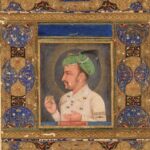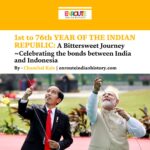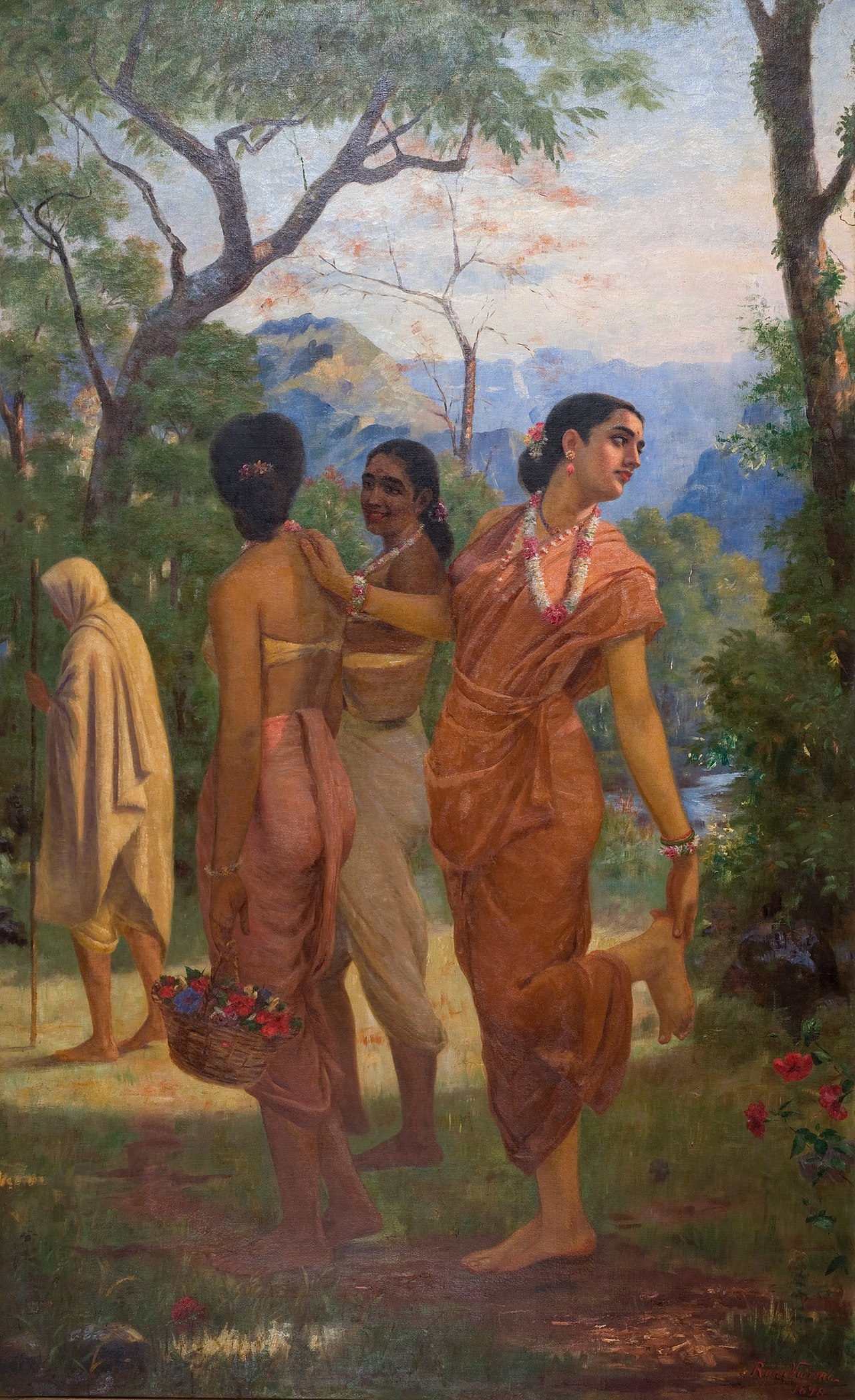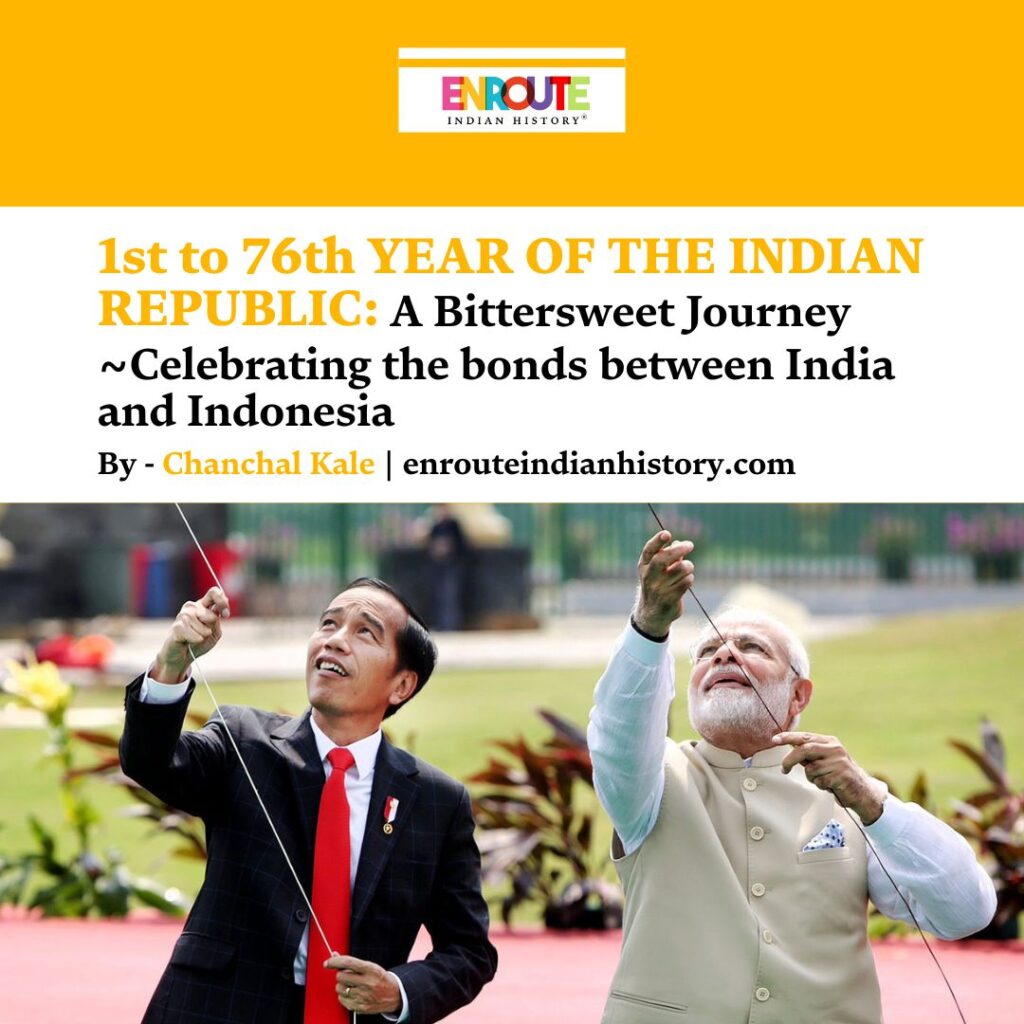
1st to 76th Year of the Indian Republic: A Bittersweet Journey
~Celebrating the bonds between India and Indonesia
Article By – Chanchal Kale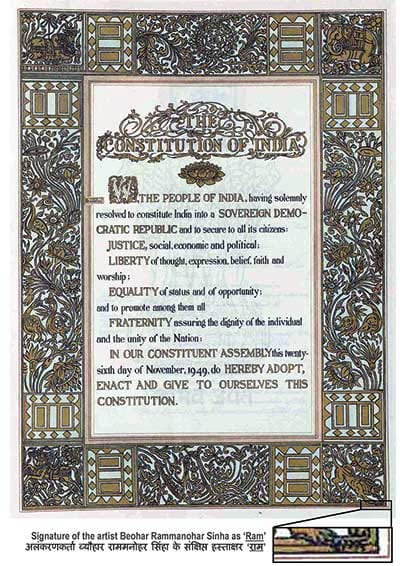
Introduction
January 26, 1950, represents a critical juncture in Indian history, marking the transition from a British Dominion to a fully Sovereign, Democratic Republic. Following the Indian Independence Act of 1947, which established the partitioned nations of India and Pakistan as independent Dominions under British rule, India operated under a transitional framework. It was on January 26, 1950, that India formally adopted its Constitution, effectively asserting its complete sovereignty and independence from any foreign governance. This date embodies the establishment of India as an autonomous nation-state founded on principles of democracy and the rule of law.
Following its independence, India strategically positioned itself on the global stage through a series of calculated diplomatic initiatives. The leadership of India at that time understood the symbolic value of Republic Day and established a precedent of inviting a foreign head of state as the chief guest for the celebrations. This diplomatic gesture has proven crucial for a nascent nation seeking recognition and influence, and it continues to serve as a vital component of India’s foreign policy framework today.
The inaugural Republic Day celebrations were attended by Indonesia’s first President, Dr. Sukarno, symbolizing the shared struggles of both newly independent nations against colonial powers. These two countries have consistently championed democratic ideals, endorsed a pluralistic cultural framework, and demonstrated progressive leadership.

Source: Instagram Better India
Left: Sukarno; Right: Jawaharlal Nehru
As we approach the 76th Republic Day in 2025, the festivities will be enhanced by the presence of H.E. Prabowo Subianto, the current President of Indonesia. Reflecting on the journey from the first Republic Day to our 76th, both nations have encountered numerous challenges while also achieving significant milestones. This complex and often bittersweet trajectory has, over time, fortified the bilateral relationship established between them.
Relations Between the Two Nations since 1950
India and Indonesia not only share a similar etymology of name, but have also interacted closely in the domain of culture, language, trade, art and architecture. There relationship can be traced back to the 2nd century C.E. when Hindu traders from South India started settling in Java. Initially, their interactions were primarily commercial, but they grew to include cultural exchanges as Hindu beliefs spread in Indonesian Islands. However, these connections diminished during Dutch colonial rule. With the rise of Indonesian nationalism and the push for independence, friendly ties between the two countries were re-established.
Cold War period
India and Indonesia maintained similar strategic perspectives during much of the Cold War, particularly between 1950-1955, which culminated in the Bandung Conference of 1955—a key moment in their relationship and a precursor to the Non-Aligned Movement in 1961. Indonesian leaders were inspired by India’s non-alignment and its resistance to U.S. influence. However, after the Bandung Conference, relations began to strain due to differing views on Communist China, which contributed to the deterioration of New Delhi-Djakarta ties.
In the early 1950s, India and Indonesia initially saw China as a respected neighbour with popular leaders. However, issues like the India-China boundary dispute, the 1959 Tibetan uprising, and India’s support for Tibet highlighted tensions in Sino-Indian relations. Nitish K. Dutta noted that Indonesians were frustrated by India’s insistence on British-imposed borders while disregarding China’s perspective, leading Indians to question Indonesia’s friendship.
David Brewster points out a significant point of contention between India and Indonesia regarding their regional ambitions. In the early 1960s, as Indonesia aimed for regional dominance by undermining Malaya’s independence, India actively supported Malaya in international forums.
The deteriorating relations were evident during the Asian Games in Djakarta in September 1962. G.D. Sondhi, the Federation’s vice-president, condemned the exclusion of China and Israel from the Games, leading to a backlash in the Djakarta press and widespread animosity toward India. After the Indian soccer team won the finals, they were booed by many in the crowd, despite clarifications about Sondhi’s personal stance.
- Brewster highlights how Indonesia countered by extending his support to Pakistan during its 1965 conflict with India. Brewster noted that President Sukarno even contemplated seizing the Andaman and Nicobar Islands to support Pakistan. This influenced the Indian Navy’s decision to remain in the Bay of Bengal and not take offensive action against Pakistan, underscoring Indonesia’s strategic importance to India.
Sukarno’s overthrow following the 1965 coup eased tensions between the two countries. Chinese influence in Indonesia diminished, prompting Jakarta to mend relations with India. Indonesia shifted focus from regional hegemony to supporting the formation of Association of South-East Asian Nations (ASEAN). Indonesia even withdrew military support for Pakistan, endorsing India’s claim over Kashmir and both the nations recognized China as the primary regional threat.
India and Indonesia intensified their bilateral cooperation during 1970s. Indian investors were invited to establish themselves in Indonesia’s textile industry. Visits by President Suharto in 1980, Prime Minister Indira Gandhi in 1981 and Rajiv Gandhi in 1986 raised the profile of the relationship in both the countries.
Post Cold War Period
After the end of the Cold War period, in 1992, India launched its “Look East” policy to promote economic engagement with the fast-growing economies of Southeast Asia. Since the early 1990s, the Indian Navy has taken an active role in extending India’s political and strategic reach into Southeast Asia. The Malacca Strait, the primary point of transit between the Pacific and Indian Oceans and a maritime “choke point,” has become a major focus of India’s regional maritime strategy. Indonesia’s geographical location between the Indian and Pacific Oceans makes it key to India’s aims to counter China’s growing maritime interests in the Indian Ocean, control the Malacca Strait, and gain a role as a naval power in the western Pacific.
In the late 1990s, Indonesia faced economic and political crises, starting with the 1997 Asian economic crisis, which severely impacted the country, leading to the fall of Suharto and the transition to democracy. In 2000, President Abdurrahman Wahid, Indonesia’s first democratically elected president, introduced an “Asianist” strategy aimed at reducing dependence on the West by forming alliances with India, China, Japan, and Singapore. During a visit to New Delhi, he proposed a triangular economic alliance between Indonesia, India, and China. However, his proposals faced criticism in Indonesia for their lack of coherence and for overlooking bilateral issues between India and China.
Brewster suggests that Indonesia may increasingly view India as an appealing security partner due to the evolving strategic relationship between India and the U.S., which aligns more closely with Indonesia’s own posture. Additionally, collaborating with India aligns with Indonesia’s ambitions to expand its influence beyond ASEAN to engage with other major powers.
Since the early 2000s, India and Indonesia have seen significant developments in their bilateral relationship, marked by increased high-level visits. During President Yudhoyono’s visit to India in November 2005, they signed a “Joint Declaration on establishing a Strategic Partnership.” Indonesia supported India’s entry into the East Asia Summit and both countries became G20 members, playing supportive roles. The focus areas include Defence, Trade, Intellectual and Scientific relations, along with cultural and people to people exchange.
- Defence
Over the last two decades, Vibhanshu Shekhar highlights that Myanmar, allied with China, poses a potential threat to India’s dominance in the northeast Indian Ocean. R. A. Supriyanto emphasizes Indonesia’s strategic geographical role in countering China’s “String of Pearls.” India has been supplying defense equipment to the Indonesian Navy and providing training to Indonesian military officers through the ITEC-I program. Since the 2001 Bilateral Agreement on Cooperative Activities in Defense, the two countries have also collaborated on non-traditional security challenges like terrorism and maritime piracy.
- Trade
An India-Indonesia Joint Commission Meeting (JCM) in September 2003 in Yogyakarta aimed to enhance bilateral economic relations and establish an “India-Indonesia Expert Working Group.” Bilateral trade increased from US$1.12 billion in 1995-96 to US$10 billion in 2010.
India mainly imports palm oil, coal, petroleum products, and spices, while Indonesia imports textile yarn, chemicals, machinery, refined petroleum, iron, steel, and grains. India is the largest importer of crude palm oil, and Indonesia is India’s second-largest trading partner in ASEAN after Singapore.
- Scientific and Technological connections
Although India and Indonesia signed an agreement on Technical and Scientific Cooperation in 1982, substantial collaboration only began after India engaged in ASEAN affairs, following Indonesia’s economic crisis.
In the past decade, their cooperation has expanded into areas like remote sensing, satellite launching, and space technologies. The Indian Space Research Organisation (ISRO) and Indonesia’s National Institute of Aeronautics and Space (LAPAN) signed a MoU in 2002 for collaboration in space applications and capacity building. LAPAN supported ISRO’s establishment of a Telemetry, Tracking and Command Centre in West Papua. On January 10, 2007, ISRO successfully launched Indonesia’s micro-satellite LAPAN TUBSAT alongside its Polar Satellite Launch Vehicle.
- Cultural and people to people exchange
The Indian government established the Jawaharlal Nehru Indian Culture Centre (JNICC) in Jakarta in 1989 to promote cultural activities in Indonesia. Indian films, often dubbed in Bahasa Indonesia, enjoy a large following there. Bali Jatra, celebrated in Odisha every November, marks the historical trade links between India and Indonesia.
The Government of India, under the General Scholarships Scheme (GSS) of Indian Council of Cultural Relations (ICCR) supports human resources development through education programs and scholarships. Indonesian students can study in India under the General Cultural Scholarship Scheme and Hindi Scholarship programs, while experts receive training through ITEC and the Colombo Plan.
Recent Strategic Actions
In January 2011, the President of Indonesia and the Prime Minister of India announced the formation of an Eminent Persons’ Group (EPG) to develop a “Vision Statement 2025” for their strategic partnership. They also set a bilateral trade target of US$50 billion by 2025 during the Prime Minister’s visit to Indonesia in May 2018. Additionally, interest among Indonesian students in studying in India is growing, with 41 ICCR scholarships awarded for the 2021-2022 academic year.
During the Covid-19 pandemic, India and Indonesia strengthened their support for each other. As part of Prime Minister Narendra Modi’s vision of SAGAR (Security And Growth for All in the Region), the Indian Navy undertook missions in the Indian Ocean for medical relief. INS Airavat, an indigenous Landing Ship Tank, completed two missions to Indonesia in July 2021, delivering 100 MT of Liquid Medical Oxygen (LMO) and 300 oxygen concentrators. The Indian Ambassador to Indonesia, H.E. Mr. Manoj Kumar Bharti, expressed gratitude to Indonesia for its assistance of 3,400 oxygen cylinders and 200 oxygen concentrators to India earlier that year.
Indonesia Chaired the G20 Presidency for the year 2022. With the theme “Recover Together, Recover Stronger”. India assumed its year-long presidency of G20 from 1st December 2022 and has held over 100 meetings in various states of India, in which Indonesian delegations have participated enthusiastically.
The two countries have enormous potential to come together to build further convergence in the sector of tourism, digital economy, education sector, artificial intelligence and automation. Both the countries have supported each other at multilateral and international forums to realise the shared vision of regional peace and stability.
Conclusion
India and Indonesia share a robust historical relationship characterized by deep-rooted cultural, commercial, and religious exchanges, shaped by shared civilizational values and extensive maritime trade networks. The trajectories of both nations in their post-colonial pursuit of democratic governance have further reinforced their bilateral ties, especially through their commitment to sovereignty and non-alignment during the Cold War era.
Economically, the two countries engage in substantial trade and investment, with key sectors including energy, palm oil, and textiles. As members of the G20, India and Indonesia collaborate on critical global challenges, including climate change and sustainable development initiatives. The significance of their partnership will be underscored through celebration of the 76th Republic Day this year, symbolizing their shared aspirations as two democracies dedicated to regional stability, mutual economic growth, and cultural coexistence.
Bibliography
- “India-Indonesia cooperation: From shared history towards a shared future”, published in The Jakarta Post, Wednesday, 26 January, 2022
- David Brewster, “India’s Defence Strategy And The India-ASEAN Relationship”, published in India-ASEAN Defence Relations S. Rajaratnam School of International Studies (2013). http://www.jstor.com/stable/resrep05896.8
- David Brewster, “The Relationship between India and Indonesia”, University of California Press, Asian Survey, Vol. 51, No. 2 (March/April 2011), pp. 221-244, http://www.jstor.org/stable/10.1525/AS.2011.51.2.221
- Vibhanshu Shekhar, “INDIA-INDONESIA RELATIONS: An Overview”, Institute of Peace and Conflict Studies (2007), http://www.jstor.com/stable/resrep09298
- Ristian Atriandi Supriyanto, “THE INDO-INDONESIAN DEFENCE RELATIONSHIP”, INDIA-ASEAN DEFENCE RELATIONS S. Rajaratnam School of International Studies (2013), http://www.jstor.com/stable/resrep05896.11
- Ratna Vadra, “India and Indonesia: Twins of A Kind”, International Journal of Economic Research Volume 16, Number 2, 2019, http: serialsjournal.com
- “INDIA – INDONESIA BILATERAL RELATIONS : BRIEF NOTE”, published by Ministry of External affairs, August 2023, mea.gov.in
- Report of the Panel Discussion on “India-Indonesia Partnership: A Renewed Understanding, New Opportunities and Critical Steps Ahead”, 17 January 2024, New Delhi https://www.ris.org.in/en/node/3829
- “Eminent Persons’ Group Report 2016”, published by Ministry of External Affairs, mea.gov.in
- Nitish K. Dutt, “INDONESIA-INDIA RELATIONS”, 1955- 67, Published in Asian Studies: Journal of Critical Perspectives on Asia, https://www.asj.upd.edu.ph/index.php/themes/53-southeast-asia


